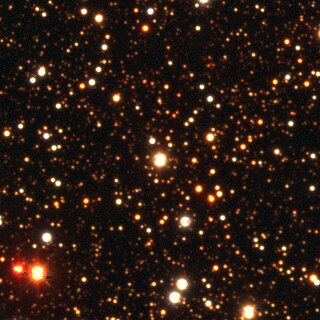Gaia BH2
Binary system in Centaurus From Wikipedia, the free encyclopedia
Gaia BH2 (Gaia DR3 5870569352746779008) is a binary system consisting of a red giant and a stellar-mass black hole. Gaia BH2 is located about 3,800 light years away (1.16 kpc away) in the constellation of Centaurus, making it as of 2024[update] the third-closest known black hole system to Earth. Gaia BH2 is the second black hole discovered from Gaia DR3 astrometric data.[3]
| Observation data Epoch J2000 Equinox J2000 | |
|---|---|
| Constellation | Centaurus |
| Right ascension | 13h 50m 16.748s[1] |
| Declination | −59° 14′ 20.33″[1] |
| Apparent magnitude (V) | 12.711[2] |
| Characteristics | |
| Red giant | |
| Evolutionary stage | Red giant |
| Black hole | |
| Evolutionary stage | Stellar black hole |
| Astrometry | |
| Radial velocity (Rv) | −5.04±2.08[1] km/s |
| Proper motion (μ) | RA: −10.48±0.1 mas/yr[3] Dec.: −4.61±0.06 mas/yr[3] |
| Parallax (π) | 0.859±0.018 mas[3] |
| Distance | 3,800 ± 80 ly (1,160 ± 20 pc) |
| Orbit[3] | |
| Period (P) | 1,276.7±0.6 d |
| Semi-major axis (a) | 4.96±0.08 AU |
| Eccentricity (e) | 0.5176±0.0009 |
| Inclination (i) | 34.87±0.34° |
| Longitude of the node (Ω) | 266.9±0.5° |
| Periastron epoch (T) | 2457438.3±1.4 |
| Argument of periastron (ω) (secondary) | 130.9±0.4° |
| Semi-amplitude (K1) (primary) | 25.23±0.04 km/s |
| Details | |
| Red giant | |
| Mass | 1.17±0.08[4] M☉ |
| Radius | 8.55+0.20 −0.15[4] R☉ |
| Luminosity (bolometric) | 24.6±1.6[3] L☉ |
| Surface gravity (log g) | 2.71±0.24[3] cgs |
| Temperature | 4,604±87[3] K |
| Metallicity [Fe/H] | −0.22±0.02[3] dex |
| Rotation | 398±5[4] days (preliminary estimate) |
| Rotational velocity (v sin i) | <1.5[3] km/s |
| Age | 5.1+1.2 −1.8[4] Gyr |
| Black hole | |
| Mass | 8.94±0.34[3] M☉ |
| Other designations | |
| Gaia BH2, UCAC4 154-126202, 2MASS J13501675-5914203, Gaia DR3 5870569352746779008 | |
| Database references | |
| SIMBAD | data |
The black hole and red giant orbit the system barycentre every 1,277 days, or around 3.5 years, with a moderate eccentricity of 0.518. The black hole's mass is around 8.94 M☉, which means its Schwarzschild radius should be about 26.4 km (16.4 mi).[3] The red giant has a mass of 1.17 M☉ and a radius of 8.6 R☉.[4] Its temperature is estimated at 4,604 K (4,331 °C; 7,828 °F).[3] The star is enriched in alpha elements, thus is believed to have undergone mass transfer with another star.[3]
Discovery
Gaia BH2 was originally discovered as a black hole binary candidate in 2022, found via astrometric observations with Gaia, along with Gaia BH1. At that time it was not clear if Gaia BH2 did definitely harbour a black hole, but it was the only plausible candidate in the Gaia data other than Gaia BH1.[5][6] Later radial velocity observations confirmed this black hole system and refined its orbital parameters.[3]
See also
References
Wikiwand - on
Seamless Wikipedia browsing. On steroids.

